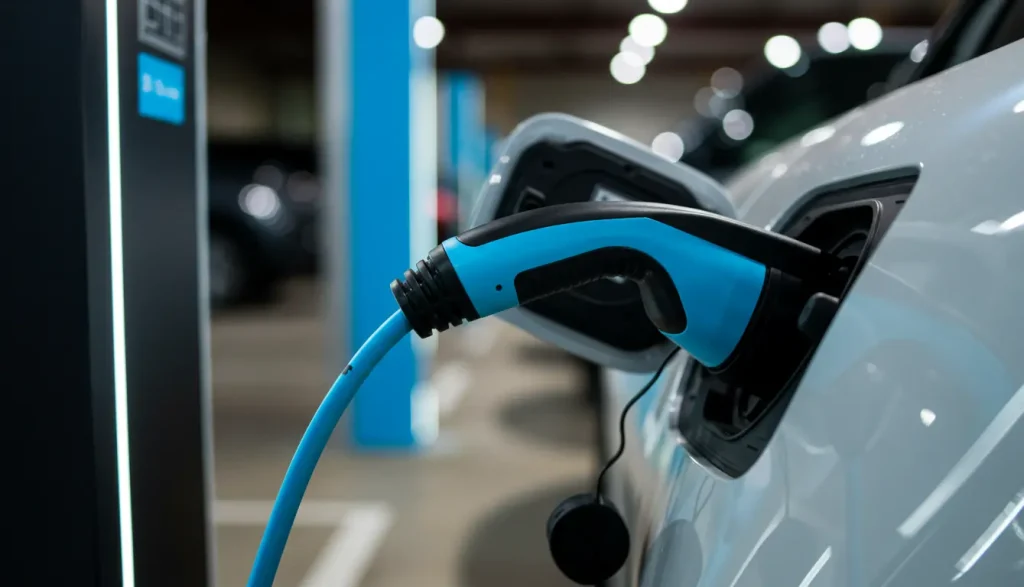EV Charging: It’s Not Just About the Plug
Electric vehicles (EVs) are popping up everywhere—from sleek city cars to powerful trucks—and they all have one thing in common: they need to be charged. You might think charging an EV is as simple as plugging it in and waiting. But in the commercial world, it’s a whole different ball game. Behind every charging point you see in a parking lot or shopping centre, there’s a whole system working to make that simple “plug and charge” experience possible.
If you’re a business looking to enter this space, or simply curious about how EV charging actually works on a larger scale, this article is for you. Let’s take a walk through what makes commercial EV charging tick—and why it’s about much more than just electricity.

The Foundation: Infrastructure That Goes Beyond Plugs
At first glance, you might compare EV charging to gas stations. But they’re not quite the same. Installing a charger isn’t as easy as just picking a spot and plugging it into a wall. Real planning is involved.
Location Still Wins
You can’t just stick a charger in any empty corner and expect success. The best locations are ones people are already visiting—shopping malls, business parks, commuter hubs. The idea is to make charging part of their daily flow, not a chore.
Also, drivers want to feel safe and comfortable. Well-lit areas, easy-to-access spots, and spaces near amenities are key. You’re not just offering electricity—you’re offering time well spent.
Reliable Power Isn’t Optional
A charger that’s out of order or too slow? That’s a bad experience waiting to happen. Commercial stations need to be connected to strong, stable power sources. And when demand peaks—say, everyone plugs in at 6 PM—you need systems in place to keep everything running smoothly.
Customer Experience: The Real Deal Maker
Let’s face it—no one wants to wrestle with a clunky app or stand around confused at a payment screen. The stations that make charging fast and hassle-free? Those are the ones drivers remember and return to.
Apps Should Be Helpful, Not Frustrating
Keep it simple. Offer multiple ways to pay—tap cards, mobile apps, or subscriptions. Make sure the interface is user-friendly. Drivers should spend less time figuring things out and more time getting on with their day.
Speed Is Everything
Time matters. Fast chargers in high-traffic areas are a major draw. If a driver knows they can get a solid top-up in under 30 minutes, they’ll be far more likely to stop by.
Comfort Counts
What do you do while waiting for a charge? That’s where smart businesses shine. Free Wi-Fi, comfy benches, clean restrooms, or nearby cafés turn waiting into relaxing. A good charging station isn’t just a pit stop—it’s a pleasant pause.
Smarter Charging Through Smarter Tech
You may not see it, but behind every good EV charger is a smart system doing a lot of heavy lifting.
Adaptive Power Saves Money and Stress
Smart systems adjust charging speed depending on the grid’s load. If it’s a high-demand time, the system slows things down or spreads the load across multiple chargers. This helps prevent blackouts and keeps your electricity bill manageable.
Data Is a Game-Changer
Every time someone plugs in, data is collected: how long they charge, how much power they use, when they visit. With this information, businesses can predict busy times, figure out where to add more chargers, and keep operations running smoothly.
Real-Time Info Builds Trust
Ever drive up to a charger and find it’s already in use? Frustrating, right? With real-time info through apps, drivers can see which chargers are free, what the wait times are, or even which nearby café has free seating. It’s about reducing stress and making things easier.
Being Green: Charging With a Conscience
EVs are cleaner than gas cars, but commercial charging stations have their own environmental responsibilities. The best operators go above and beyond.
Solar Panels and Wind Turbines
Many stations are now adding renewable energy sources on-site. It cuts down on electricity costs and appeals to eco-conscious drivers. It’s not just good for the planet—it’s smart business.
Store Power for Later
Battery systems allow stations to store energy during off-peak times or when renewables are generating extra power. That way, they can use it later when demand spikes or prices go up.
Offset What You Can’t Eliminate
Even the greenest business can’t avoid every bit of emissions. Carbon offset programs let operators balance things out and show customers they care about more than just profit.
Regulations: Know the Rules, Stay Ahead
This industry is moving fast, and governments are watching closely. Rules change from region to region, and staying up to date is essential.
It’s Not Just About Safety
Yes, your station needs to be safe and accessible, but regulations also include how you handle customer data, how you bill users, and even how your infrastructure interacts with the grid. Staying compliant keeps you competitive.
Interoperability Is the Future
No one wants five different apps just to charge their car. Stations that allow drivers from different networks to plug in and pay without hassle will dominate the market. It’s all about freedom and convenience.
Profitability: Yes, It Can Make Money
A lot of businesses wonder if EV charging is worth the cost. It can be—but only if you build it right from the start.
Understand Your Costs
You’ve got to consider hardware, installation, maintenance, power bills, and customer service. All of this adds up. But with a well-thought-out pricing model, you can cover costs without scaring away customers.
Think Beyond Charging Fees
Some stations make money by bundling parking fees, selling food or drinks nearby, or offering subscriptions. The more value you add, the more income streams you create.
Challenges: What You’re Up Against
Even in a booming market, EV charging has its pain points.
The Grid Can’t Handle It All
As more people buy EVs, more strain is placed on local power grids. Without proper planning, stations could face blackouts or slowdowns. Smart grid partnerships and battery storage are vital for keeping things smooth.
Cybersecurity Is Critical
With payments, apps, and personal data flying around, charging networks are targets for hackers. Investing in strong cybersecurity isn’t optional—it’s essential to protect your brand and your users.
What’s Coming Next? The Future Is Closer Than You Think
EV charging isn’t slowing down—it’s speeding up.
Wireless Charging
Imagine parking your car over a pad and walking away, knowing it’s charging without a cable. This is already being tested and could soon become common.
Cars That Share Power
New tech called vehicle-to-grid (V2G) allows EVs to send power back to the grid during peak hours. It’s like turning your car into a mini power plant—and stations that support this will be ahead of the curve.
Ultra-Fast Charging
Soon, charging an EV could take as little time as filling a gas tank. Next-gen chargers will deliver hundreds of miles of range in under 15 minutes.
Final Thoughts: More Than Just a Plug
At the end of the day, commercial EV charging is about more than just transferring electricity from a socket to a car. It’s about building a better experience for people, being smart about energy, and staying green and future-ready.
For businesses, it means thinking beyond hardware—into how people interact, how technology empowers them, and how the whole system can evolve with time. The companies that understand this aren’t just charging cars—they’re charging ahead.






